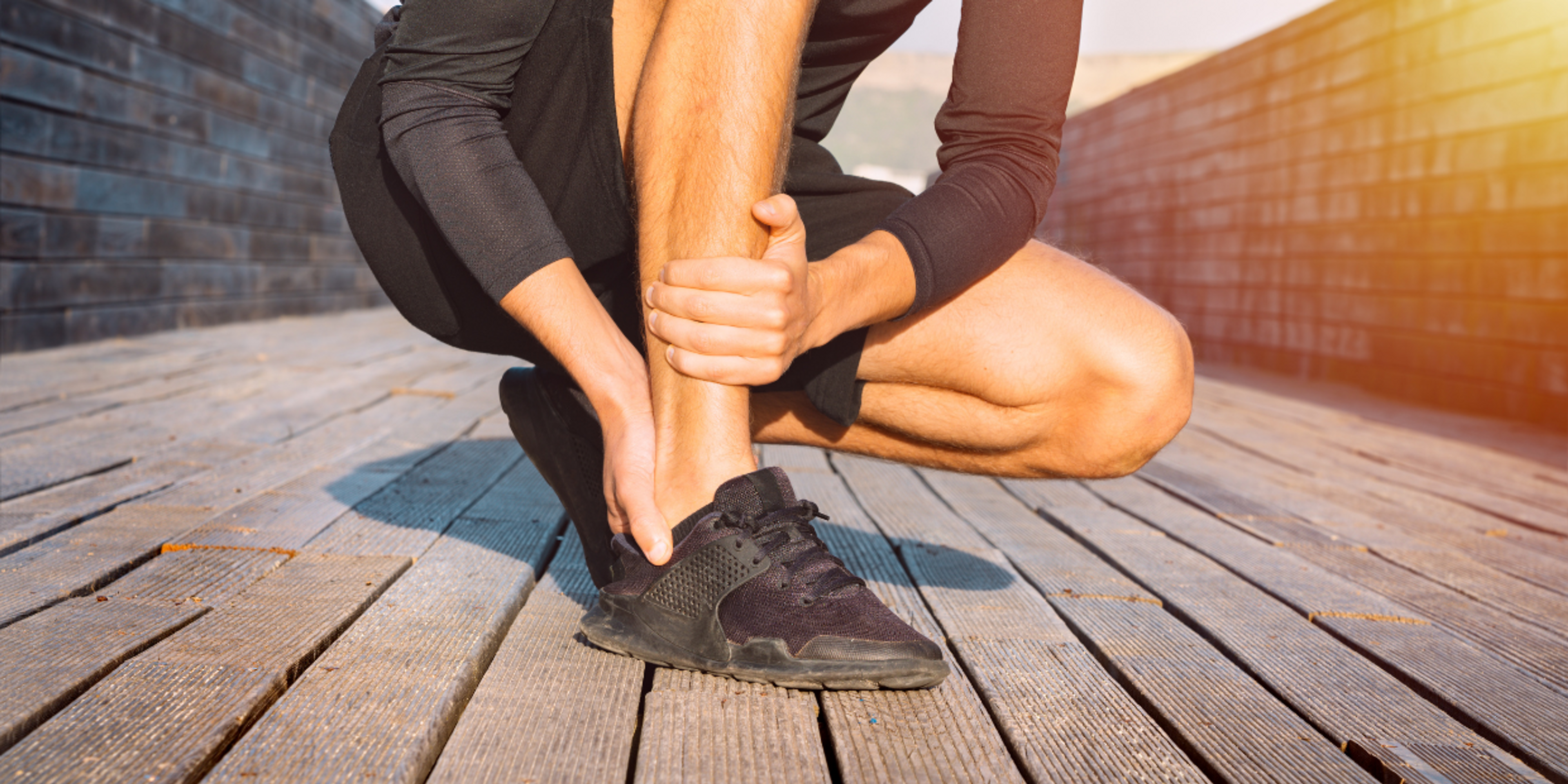Home treatment for Achilles tendonitis: The top 3 proven strategies
Add these 3 science-backed strategies to your Achilles tendonitis home treatment and you’ll be back on your feet pain-free and doing the activities you love, sooner.
Can Achilles tendonitis be treated at home?
Yes! Studies show that the best way to treat Achilles tendonitis is by combining strategies to:
- Reduce the load on your injured tendon, and
- Progressively strengthen it.
The best part? You can implement these strategies effectively at home.
The 3 best home treatments for Achilles tendonitis
Next, we’ll explain how to implement each of these strategies into your Achilles tendonitis treatment at home, why they work, and what to avoid to prevent flare-ups.
1. Rest, but not too much
When you injure your Achilles tendon, it loses some of its strength. As a result, it can’t tolerate the loads and forces created during your sport and daily activities, including walking, stair climbing, running, and jumping.
To allow your tendon to heal, you have to reduce the load passing through it temporarily – only working it at a level it can currently handle.
Why is relative rest best?
You don't have to rest your tendon completely to recover from Achilles tendonitis. In fact, avoiding all movement of your injured Achilles tendon can make it feel worse.
That’s where relative rest comes in.
Relative rest simply means reducing your activities, for example, walking, running, jumping, etc., to a level that doesn’t irritate your tendon (we discuss how to monitor this in the following sections).
In contrast, resting completely for longer than a few days can lead to your Achilles tendon losing even more strength and slowing your recovery.
Staying active within these limits helps maintain your tendon’s remaining strength and improves circulation, which promotes healing.
How much should you rest?
The extent of your Achilles tendon injury will determine the amount of rest and activity reduction you need.
Some people can continue running with Achilles tendonitis, albeit less frequently and at a slower pace. Others might need to stop running altogether and do lower-impact activities like cycling. In more severe cases, even walking volume may need to be limited.
It all depends on your unique injury case and what your Achilles tendon can handle.
Deciding what activity level is OK
Managing Achilles tendonitis can be tricky because injured tendons often have a delayed symptom response.
That means your tendon may feel fine while you’re doing an activity or exercise, but it can significantly worsen several hours later.
To know your tendon limits and keep working within them, you’ll need to carefully observe how your tendon reacts during your various activities and in the 24 hours after – then adapt them accordingly.
The ‘golden rule’ in Achilles tendonitis rehab is if an activity or exercise increases your Achilles pain or stiffness, it is usually OK to do as long as:
- It only causes a slight discomfort in your tendon while doing it, AND
- The increased pain and/or stiffness does not last longer than 24 hours.
The most revealing time for observing your Achilles tendon symptoms is often first thing in the morning.
If you notice that your Achilles feels significantly more uncomfortable (compared to the previous day) when you take your first few steps in the morning, it’s usually a sign you overdid it the day before. In that case, you’ll need to adapt your activity and reassess.
Finding the right level to work at can take a while, and flare-ups are common. Remembering this when doing your Achilles tendonitis treatment at home can be helpful.
Learning to handle painful injury flare-ups effectively will ensure you stay on track with your recovery.
We’ve designed the Achilles tendonitis rehab plan in the Exakt Health app to guide you smoothly through the recovery process. It helps you stay within your limits and avoid flare-ups, offering expert advice to keep you on track – even if flare-ups occur. You can download and trial it for free from the app store.
2. Wear the right shoes and inserts
If you have Achilles tendonitis, the type of shoes you wear can make a significant difference to your pain. Assessing and addressing your footwear is a simple and effective strategy to add to your Achilles tendonitis home treatment plan.
How shoes can affect your Achilles tendon
Standing or walking in flat shoes (like sandals) causes your Achilles tendon to stretch more. Usually, this is not a problem. But if your tendon is injured, wearing flat shoes can aggravate your symptoms.
Choosing shoes with a slightly raised heel (like most running shoes) or using heel lift inserts can help reduce the load on your Achilles tendon.
This simple strategy can help settle your pain quickly, often enabling people to walk and run more pain-free sooner.
If your Achilles tendon is very painful, combining heeled shoes with heel lift inserts may be necessary until your pain settles.
What to look out for in a shoe
If you’re dealing with Achilles tendon pain or tendonitis, choose shoes that:
- Lift your heels higher than your toes (between 1 to 2 centimeters is usually enough), and
- Do not press directly into the painful area of your Achilles.
3. Do exercises that restore your tendon’s strength
The only way to restore your injured tendon’s strength properly is by doing targeted exercises tailored to your unique type and stage of injury and activity needs.
The good news is you can easily do these exercises at home, with no fancy equipment required.
The best Achilles tendonitis home treatment exercises
Calf raise exercises are the best exercises for strengthening your Achilles tendon because:
- They target your calf and Achilles tendon
- They are simple and convenient to do in most environments and schedules
- They can easily be adapted to increase your Achilles tendon load
You can adjust the load passing through your Achilles tendon by changing the way you do your calf raises. Typical calf raise exercise variations include:
- Standing on two legs vs. one leg
- Lowering your heel to the floor level vs. over the side of a step
- Using your bodyweight only vs. using extra weights
- Performing slow vs. fast movements
How to do your home exercises correctly
Exercise at the right level for you
Regardless of where you are in your rehab, matching your exercises to your Achilles tendon’s current strength and capacity is crucial. Otherwise, you risk worsening your pain.
Progress your exercises gradually
To strengthen your Achilles tendon effectively, you need to gradually increase the intensity of your exercises. Aim to match your Achilles tendon loading capacity with the demands of your sport or activities.
If you’d like to learn more about progressing correctly, our article about how to adapt your calf raise exercises explains this in detail.
The Achilles rehab plan in the Exakt app is designed to take you through your rehab process from start to finish effortlessly. It provides personalized exercises to suit your injury, expert guidance to ensure you work at the right level, and gradual progression based on your feedback.
Achilles tendonitis home remedies to avoid
A commonly recommended home treatment for Achilles tendon pain is calf stretches.
However, it’s best to avoid calf stretches when you have an Achilles tendon injury – particularly in the early stages of your Achilles tendon injury.
Calf stretches may relieve your Achilles tendon pain while doing them, but they can often increase your pain hours later. This is especially true for insertional Achilles tendonitis.
Curious about why this happens? Head over to our article explaining why stretching can worsen your Achilles tendonitis and what you can do instead to help relieve your symptoms.
Conclusion
Here are a few key takeaways from this article you can use, share, or refer to later in your:
- You can effectively treat Achilles tendonitis at home by combining 3 simple strategies to reduce your Achilles tendon load and build its strength.
- The best way to reduce your Achilles tendon load is with relative rest and wearing the right shoes and heal inserts (if/when necessary).
- The best way to restore your Achilles tendon strength is with tailored calf raise exercises that increase intensity over time.
- You can prevent your injury from worsening by starting and progressing your exercises correctly and avoiding calf stretches.
And that’s it! Now you know how to effectively treat your Achilles tendonitis at home, what works best, and why.
Good luck with your recovery!
Ready to rehab? Simply download the app and choose the Achilles tendonitis plan that suits you best. You’ll have expert advice and easy-to-folow instructions right at your fingertips, helping you make a speedy recovery and get back back to doing the things you sooner.



